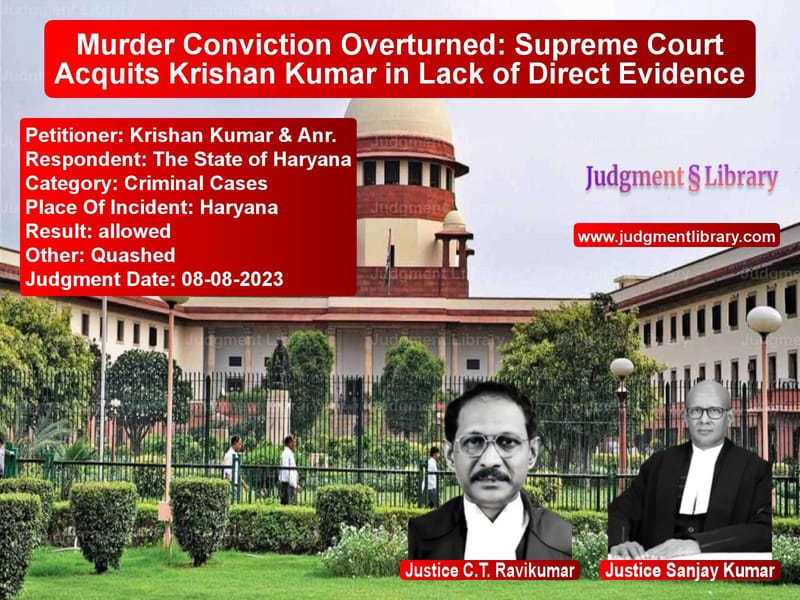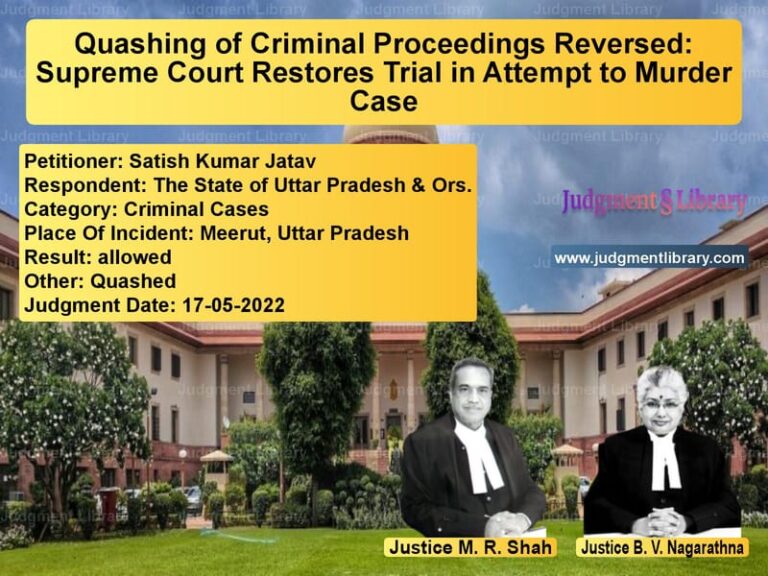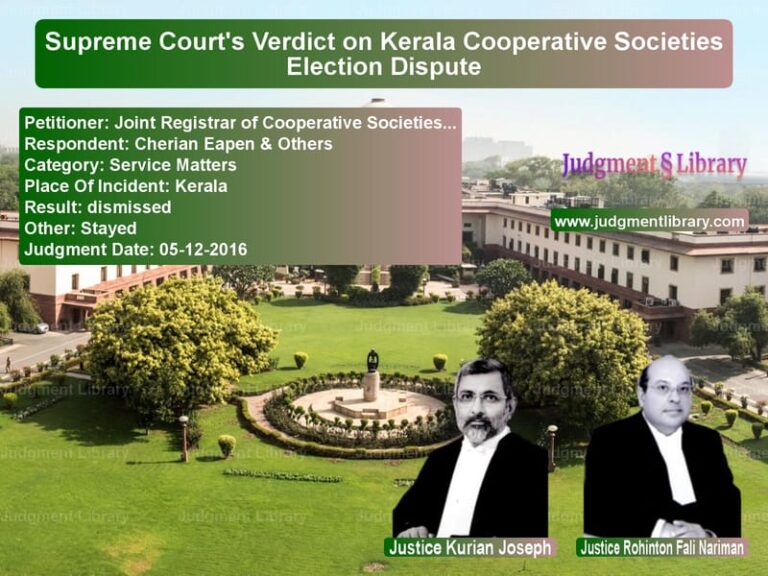Murder Conviction Overturned: Supreme Court Acquits Krishan Kumar in Lack of Direct Evidence
The Supreme Court of India recently overturned the conviction of Krishan Kumar & Another vs. The State of Haryana in a significant ruling that scrutinized the role of circumstantial evidence in criminal cases. The judgment, delivered by C.T. Ravikumar and Sanjay Kumar, set aside the High Court’s confirmation of life imprisonment for the accused, citing lack of direct evidence and procedural lapses.
Background of the Case
The case involved the alleged murder of Devinder @ Kala, a young student, whose body was found floating in the Western Yamuna Canal on June 28, 1999. Initially, the case was registered as an abduction under Section 364 of the IPC, but after statements from key witnesses, it was amended to include charges under Sections 302 (murder) and 201 (causing disappearance of evidence) of the IPC.
Chronology of Events
- June 25, 1999: Devinder was last seen going to irrigate his land and subsequently went missing.
- June 26, 1999: His brother, Krishan Kumar (PW-9), filed a missing report.
- June 28, 1999: A decomposed body was found under the Western Yamuna Canal Bridge and identified as Devinder.
- July 9, 1999: The accused allegedly made an extra-judicial confession to PW-7, revealing details of the crime.
- 2002: The Trial Court convicted the accused based on circumstantial evidence.
- 2014: The Punjab and Haryana High Court upheld the conviction.
- 2023: The Supreme Court acquitted the accused.
Prosecution’s Arguments
The prosecution built its case on circumstantial evidence, arguing that:
- The accused had a motive, as they found Devinder in a compromising position with their sister, Poonam.
- Witnesses (PW-8 and PW-10) saw the accused near the scene of the crime.
- The accused made an extra-judicial confession before PW-7.
- The murder weapon, a chunni allegedly used to strangle Devinder, was recovered.
Defense’s Arguments
The defense countered that:
- There was no direct evidence linking the accused to the crime.
- The ‘last seen’ theory was improperly applied since no witness saw the accused and the deceased together just before the murder.
- The extra-judicial confession was unreliable and obtained under suspicious circumstances.
- The postmortem report’s estimated time of death conflicted with the prosecution’s narrative.
Supreme Court’s Analysis
The Supreme Court focused on the lack of concrete evidence tying the accused to the crime. It made the following key observations:
“Judicial verdicts must be based on established facts, not conjectures or assumptions. The burden of proof lies on the prosecution, which failed to provide conclusive evidence.”
The Court critically analyzed each piece of circumstantial evidence:
- Last Seen Theory: The Court noted that none of the 17 prosecution witnesses had seen the accused and the deceased together before the crime. It cited State of UP v. Satish (2005) 3 SCC 114, emphasizing that ‘last seen’ can only be applied when the time gap is minimal.
- Extra-Judicial Confession: The Court rejected the confession, noting that it lacked credibility and was not corroborated by other evidence.
- Forensic Evidence: The postmortem report suggested the time of death did not align with the prosecution’s version, casting doubt on the entire narrative.
- Recovery of Murder Weapon: The chunni was found in an open area accessible to many people, making it an unreliable piece of evidence.
Key Judicial Observations
The Court strongly criticized the manner in which the prosecution built its case:
“In criminal trials, there is no room for conjectures and surmises. The prosecution must establish its case as it puts forth, and if it fails, courts cannot manufacture a new case for them.”
It also reiterated the principle that in cases based on circumstantial evidence, the chain of events must be so complete that it rules out every hypothesis except the guilt of the accused. The Court held:
“The prosecution’s failure to present conclusive evidence means the accused must be given the benefit of the doubt.”
Final Verdict
The Supreme Court set aside the High Court’s ruling and acquitted the accused, concluding:
- There was no direct evidence proving the accused’s guilt.
- The circumstantial evidence was insufficient to support a conviction.
- The benefit of the doubt must be given to the accused in the absence of a strong evidentiary foundation.
With this judgment, the Supreme Court reaffirmed the fundamental principle of criminal jurisprudence: “A person is innocent until proven guilty beyond a reasonable doubt.”
Petitioner Name: Krishan Kumar & Anr..Respondent Name: The State of Haryana.Judgment By: Justice C.T. Ravikumar, Justice Sanjay Kumar.Place Of Incident: Haryana.Judgment Date: 08-08-2023.
Don’t miss out on the full details! Download the complete judgment in PDF format below and gain valuable insights instantly!
Download Judgment: krishan-kumar-&-anr.-vs-the-state-of-haryana-supreme-court-of-india-judgment-dated-08-08-2023.pdf
Directly Download Judgment: Directly download this Judgment
See all petitions in Murder Cases
See all petitions in Judgment by C.T. Ravikumar
See all petitions in Judgment by Sanjay Kumar
See all petitions in allowed
See all petitions in Quashed
See all petitions in supreme court of India judgments August 2023
See all petitions in 2023 judgments
See all posts in Criminal Cases Category
See all allowed petitions in Criminal Cases Category
See all Dismissed petitions in Criminal Cases Category
See all partially allowed petitions in Criminal Cases Category







